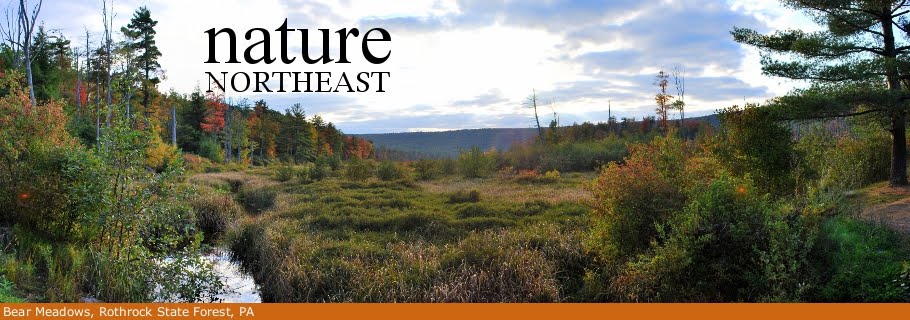After spending most of my life in Ocean Spray country, I can finally say that I witnessed a cranberry harvest.
My timing was perfect. I had just left Myles Standish State Forest in Carver, MA after exploring its pinelands, and suddenly on my left-hand side, I saw millions of floating cranberries that were being corralled as if part of some strange water rodeo. The entire harvesting process was really quite a spectacle, and George, the cranberry bog owner, was kind enough to explain the steps to me.
 |
| Cranberry (Vaccinium macrocarpon) |
The cranberry is a native trailing shrub that occurs in bogs and wetlands throughout the Northeast. Its small evergreen leaves are alternately arranged on thin, wiry stems, and though plants seldom grow taller than 8 inches, the trailing stems can spread up to 6 feet in every direction.
Cranberry flowers bloom from June through mid-July and the corollas can range from pink to white. Unlike its blueberry relatives which have their petals fused into a bell or urn shape, the cranberry corolla is deeply divided into four segments, giving the illusion of four distinct petals. These divisions are strongly reflexed, which exposes the plant's reproductive structures and makes them more accessible to pollinating insects.
After the flowers are pollinated, the ovaries swell, first turning a greenish-white color. At this stage, the fruits are barely noticeable beneath the tangled mat of vines. However, when cranberries mature to their distinctive red hue in September and October, the plump fruits become very obvious and appear to be screaming, 'eat me!'
Now back to the cranberry harvest.
Contrary to popular belief, cranberries are not grown underwater. Cranberries are actually cultivated on very sandy soils and generally require irrigation during the growing season.
 | |
| Cranberry Bogs. Note the pumphouse at center and the sand being excavated in the background. Sand is applied to bogs every few years to stimulate cranberry growth and control weeds. |
In the fall, pumps are used to flood the bogs for the harvest. After the water level is about 6-8 inches above the cranberry plants, a device called a 'water reel' is passed over the crop to dislodge the fruits from the vines. Because cranberries have large pockets of air inside the fruits, they float to the surface.
The masses of floating cranberries are then corralled with 'harvest booms,' which are essentially the same kind of floating plastic liners used to contain oil spills. Once the cranberries are contained, they are removed from the bog with a pump or a specialized conveyor belt and loaded onto a truck. Finally, the cranberries are transported to a facility to be cleaned and separated. The lucky cranberries will end up on your table this Thanksgiving while others will be frozen and stored for future use.
The masses of floating cranberries are then corralled with 'harvest booms,' which are essentially the same kind of floating plastic liners used to contain oil spills. Once the cranberries are contained, they are removed from the bog with a pump or a specialized conveyor belt and loaded onto a truck. Finally, the cranberries are transported to a facility to be cleaned and separated. The lucky cranberries will end up on your table this Thanksgiving while others will be frozen and stored for future use.
 |
| After being dislodged from the plants, the cranberries are corralled with 'harvest booms.' |
 |
| The cranberries are then pumped from the bog. |
 | ||||||||
| The mixture of cranberries and water is pumped onto the red truck and separated with a screen. The water is returned to the bog and the cranberries are loaded onto a second vehicle that will transport them to Ocean Spray's facilities. |
I should note that not all cranberries are wet harvested. George explained that he used to dry-pick his crop with the aid of a walk-behind mechanical picker. In Massachusetts, about 10% of the cranberry crop is still harvested this way. The process may be time and labor intensive, but it produces a higher quality product that can be sold at a premium. Dry-harvested cranberries will end up at farmer's market or in your grocer's produce section while wet-harvested fruits will be processed into sauces, juices, and other products.
Now that you are all-knowing about cranberry production, you might feel compelled to cook something with this 'super-fruit.' Naturally, the Ocean Spray website has plenty of recommendations. My personal favorite for Thanksgiving is the 'Homemade Whole Berry Cranberry Sauce.' It is absurdly easy to make, and yet oh-so good.
Now that you are all-knowing about cranberry production, you might feel compelled to cook something with this 'super-fruit.' Naturally, the Ocean Spray website has plenty of recommendations. My personal favorite for Thanksgiving is the 'Homemade Whole Berry Cranberry Sauce.' It is absurdly easy to make, and yet oh-so good.

Did you take these photos?
ReplyDeleteYes, I did. They were taken on Cranberry Road (no joke) in Carver, MA.
ReplyDeletemuy interesante...i like cranberries in prosecco with a little sugar. you feel classy, buzzed, and nutritious!
ReplyDelete